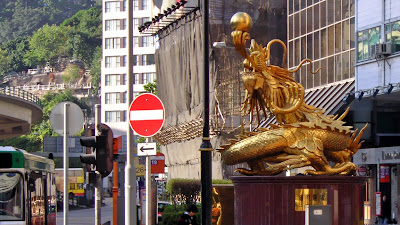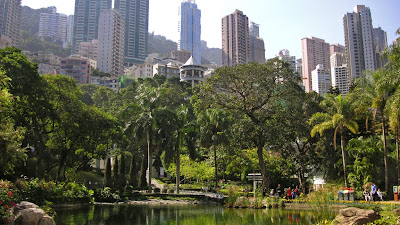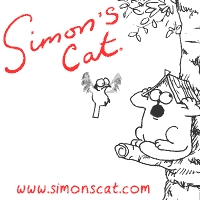Our second day on Lantau Island continued by visiting the giant Buddha, after we first toured the Po Lin Monastery. The photos below show the Buddha, Ngong Ping and a little bit of Hong Kong’s SoHo district which we walked through at the end of the day.

Tian Tan Buddha, the world’s largest Buddha statue. It’s made of bronze and is 112 ft. tall and weighs 280 tons.

The Buddha rests on top of a three-story base, which houses a museum and the Hall of Remembrance.

Smaller statues surround the large Buddha...including a “statue” of George.

The scenery on Lan Tau Island is beautiful. Lush mountain ranges are surrounding the monastery. This was one view from atop the hill of the big Buddha. Notice the small pagoda sticking out of the forest.

The opposite side offered views of the South China Sea.

After climbing down those steps again we needed a little break in form of ice cream bars and some Cokes. Dried seafood didn’t sound that refreshing.

The swastika has a complete different meaning in Asian cultures. It dates back more than 4,000 years and depending on the region it either represents the sun, the universe or simply means good luck. Unfortunately, in more recent history this symbol has been misrepresented and misused on countless occasions and took on a completely different meaning in Western cultures.

This sign just cracked us up. Yes, there is also a “female” toilet. And no, there weren’t any holes in the ground either. Those types of toilets are mostly found in mainland China.

The wooden columns of the Wisdom Path, near the monastery.

Close-up of the wooden columns, with various text of wisdom carved into.

One of many nature trails.

With the South China Sea in the background.

A make-shift sign, calligraphed by hand, that we saw along the way while walking through the forest to the Wisdom Path.

Ngong Ping Village, with the giant Buddha in the background. From here we took a different route back to the city...via a suspended cable car.

The Ngong Ping 360 cable car is a 5.7 km long bi-cable gondola lift system. It’s linked between Tung Chung, where it connects to the MTR subway station, and Ngong Ping. Along the way one can see the mountain ranges, canyons, the ocean and the comings and goings of the busy Hong Kong International airport in the distance.

Tian Tan Buddha, the world’s largest Buddha statue. It’s made of bronze and is 112 ft. tall and weighs 280 tons.

The Buddha rests on top of a three-story base, which houses a museum and the Hall of Remembrance.

Smaller statues surround the large Buddha...including a “statue” of George.

The scenery on Lan Tau Island is beautiful. Lush mountain ranges are surrounding the monastery. This was one view from atop the hill of the big Buddha. Notice the small pagoda sticking out of the forest.

The opposite side offered views of the South China Sea.

After climbing down those steps again we needed a little break in form of ice cream bars and some Cokes. Dried seafood didn’t sound that refreshing.

The swastika has a complete different meaning in Asian cultures. It dates back more than 4,000 years and depending on the region it either represents the sun, the universe or simply means good luck. Unfortunately, in more recent history this symbol has been misrepresented and misused on countless occasions and took on a completely different meaning in Western cultures.

This sign just cracked us up. Yes, there is also a “female” toilet. And no, there weren’t any holes in the ground either. Those types of toilets are mostly found in mainland China.

The wooden columns of the Wisdom Path, near the monastery.

Close-up of the wooden columns, with various text of wisdom carved into.

One of many nature trails.

With the South China Sea in the background.

A make-shift sign, calligraphed by hand, that we saw along the way while walking through the forest to the Wisdom Path.

Ngong Ping Village, with the giant Buddha in the background. From here we took a different route back to the city...via a suspended cable car.

The Ngong Ping 360 cable car is a 5.7 km long bi-cable gondola lift system. It’s linked between Tung Chung, where it connects to the MTR subway station, and Ngong Ping. Along the way one can see the mountain ranges, canyons, the ocean and the comings and goings of the busy Hong Kong International airport in the distance.
The ride took approximately 25 minutes and passed several angle stations. At the last angle station the gondola turned 60 degrees before flying over Tung Chung Bay and heading down into the terminus station.

After the sun was setting we were back again in the bustling city streets of Hong Kong. Here we are in SoHo, surrounded by even more people, traffic, shops and street markets. We found this street stand where a man made the most delicious juices out of all the most exotic fresh fruits. You won’t find any of these at any Trader Joe’s or Whole Foods either.

More interesting angles of impressive modern architecture in the city.
I will try to post more photos of our remaining time in Hong Kong over the next few days.
再見
















































